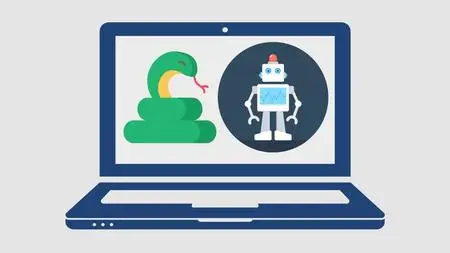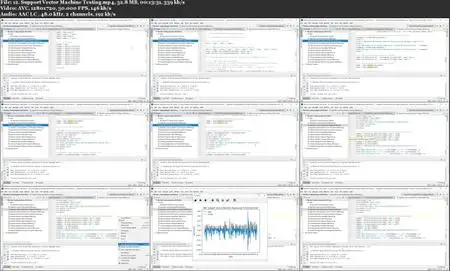Machine Trading Analysis with Python
.MP4, AVC, 1280x720, 30 fps | English, AAC, 2 Ch | 6h 3m | 872 MB
Instructor: Diego Fernandez
.MP4, AVC, 1280x720, 30 fps | English, AAC, 2 Ch | 6h 3m | 872 MB
Instructor: Diego Fernandez
Learn machine trading analysis from basic to expert level through a practical course with Python programming language.
What you'll learn
Read or download S&P 500® Index ETF prices data and perform machine trading analysis operations by installing related packages and running code on Python IDE.
Define target and predictor algorithm features for supervised regression machine learning task.
Select relevant predictor features subset through univariate filter methods, deterministic wrapper methods and embedded methods.
Implement false discovery rate, family-wise error rate for univariate methods, recursive feature elimination for deterministic wrapper methods and least absolute shrinkage and selection operator for embedded methods.
Extract predictor features transformations through principal component analysis.
Train algorithm for mapping optimal relationship between target and predictor features through ensemble methods, maximum margin methods and multi-layer perceptron methods.
Apply gradient boosting machine regression for ensemble methods, radial basis function support vector machine regression for maximum margin methods and artificial neural network regression for multi-layer perceptron methods.
Test algorithm for evaluating previously optimized relationship forecasting accuracy through scale-dependent metrics.
Assess mean absolute error, mean squared error and root mean squared error for scale-dependent metrics.
Calculate machine trading strategies for algorithms with highest forecasting accuracy.
Generate buy or sell trading signals based on target feature prediction crossing centerline cross-over threshold.
Produce long-only trading positions associated to trading signals.
Evaluate machine trading strategies performance against buy and hold benchmark using annualized return, annualized standard deviation, annualized Sharpe ratio metrics and cumulative returns chart.
Requirements
Python programming language is required. Downloading instructions included.
Python Distribution (PD) and Integrated Development Environment (IDE) are recommended. Downloading instructions included.
Practical example data and Python code files provided with the course.
Prior basic Python programming language knowledge is useful but not required.
Description
Learn machine trading analysis through a practical course with Python programming language using S&P 500® Index ETF historical data for back-testing. It explores main concepts from basic to expert level which can help you achieve better grades, develop your academic career, apply your knowledge at work or do your research as experienced investor. All of this while exploring the wisdom of Nobel Prize winners and best practitioners in the field.
Become a Machine Trading Analysis Expert in this Practical Course with Python
Read or download S&P 500® Index ETF prices data and perform machine trading analysis operations by installing related packages and running code on Python IDE.
Define target and predictor algorithm features for supervised regression machine learning task.
Select relevant predictor features subset through univariate filter methods, deterministic wrapper methods and embedded methods.
Implement false discovery rate, family-wise error rate for univariate methods, recursive feature elimination for deterministic wrapper methods and least absolute shrinkage and selection operator for embedded methods.
Extract predictor features transformations through principal component analysis.
Train algorithm for mapping optimal relationship between target and predictor features through ensemble methods, maximum margin methods and multi-layer perceptron methods.
Apply gradient boosting machine regression for ensemble methods, radial basis function support vector machine regression for maximum margin methods and artificial neural network regression for multi-layer perceptron methods.
Test algorithm for evaluating previously optimized relationship forecasting accuracy through scale-dependent metrics.
Assess mean absolute error, mean squared error and root mean squared error for scale-dependent metrics.
Calculate machine trading strategies for algorithms with highest forecasting accuracy.
Generate buy or sell trading signals based on target feature prediction crossing centerline cross-over threshold.
Produce long-only trading positions associated to trading signals.
Evaluate machine trading strategies performance against buy and hold benchmark using annualized return, annualized standard deviation, annualized Sharpe ratio metrics and cumulative returns chart.
Become a Machine Trading Analysis Expert and Put Your Knowledge in Practice
Learning machine trading analysis is indispensable for finance careers in areas such as computational finance research, computational finance development, and computational finance trading mainly within investment banks and hedge funds. It is also essential for academic careers in computational finance. And it is necessary for experienced investors computational finance trading research and development.
But as learning curve can become steep as complexity grows, this course helps by leading you step by step using S&P 500® Index ETF prices historical data for back-testing to achieve greater effectiveness.
Content and Overview
This practical course contains 41 lectures and 6 hours of content. It’s designed for all machine trading analysis knowledge levels and a basic understanding of Python programming language is useful but not required.
At first, you’ll learn how to read or download S&P 500® Index ETF prices historical data to perform machine trading analysis operations by installing related packages and running code on Python IDE.
Then, you’ll define target and predictor features for supervised regression machine learning task. After that, you’ll select relevant predictor features subset through univariate filter methods, deterministic wrapper methods and embedded methods. Next, you’ll implement false discovery rate, family-wise error rate for univariate methods, recursive feature elimination for deterministic wrapper methods and least absolute shrinkage and selection operator for embedded methods. Later, you’ll extract predictor features transformations through principal component analysis.
Next, you’ll train algorithm for mapping optimal relationship between target and predictor features through ensemble methods, maximum margin methods and multi-layer perceptron methods. Then, you’ll apply gradient boosting machine regression for ensemble methods, radial basis function support vector machine regression for maximum margin methods and artificial neural network regression for multi-layer perceptron methods. After that, you’ll test algorithm for evaluating previously optimized relationship forecasting accuracy through scale-dependent and scale-independent metrics. Later, you’ll assess mean absolute error, mean squared error and root mean squared error for scale-dependent metrics.
After that, you’ll calculate machine trading strategies for algorithms with highest forecasting accuracy. Then, you’ll generate buy or sell trading signals based on target feature prediction crossing centerline cross-over threshold. Next, you’ll produce long-only trading positions associated to trading signals.
Finally, you’ll measure machine trading strategies performance against buy and hold benchmark through annualized return, annualized standard deviation, annualized Sharpe ration and cumulative returns chart.
Who this course is for:
Undergraduates or postgraduates who want to learn about machine trading analysis using Python programming language.
Finance professionals or academic researchers who wish to deepen their knowledge in computational finance.
Experienced investors who desire to research machine trading strategies.
This course is NOT about “get rich quick” trading strategies or magic formulas.





